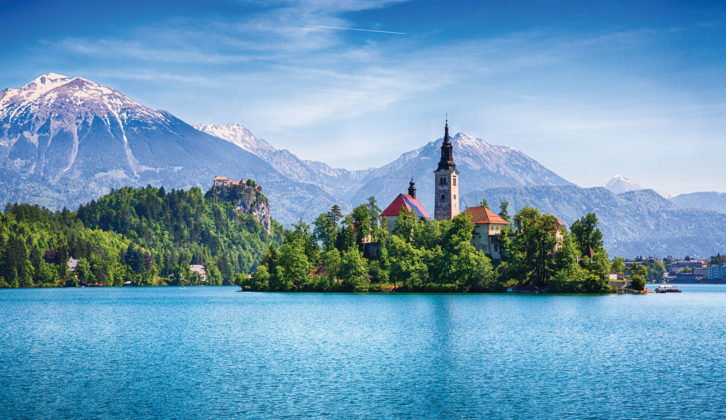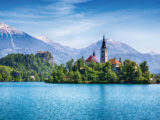Where was the site? The guidebook said it was easy to find – but our faulty sat nav placed it in the sea! It was one of those days: we missed a turn in Trieste, then had to return through the centre of the city.
Now, though, we were in Rovinj, Croatia, and had taken several different roads, at one point arriving at the Old Town.
We managed to retrace our steps, however, as we didn’t want to drive up the cobbled streets. Luckily, we spotted a man cutting a hedge, so I jumped out and asked him for directions to Campsite Veštar.
Reaching the site, we pitched up – too tired to do much other than cook a quick dinner – and settled in for the night.
The next day we explored the site, checking out the pool, shops and restaurant, and the nearby beach.
Then we drove into Rovinj, parking on the seafront, where tourist and fishing boats berth. Rovinj is on the Adriatic, on the Istrian Peninsula. The town is on its own peninsula, too, with the Venetian influence very evident in the Old Town. Boat trips run from here to Venice and Ravenna.
Gorgeous blue waters
We strolled into the Old Town, heading for the church, pausing at a café for refreshments. It was lovely just to stop, people-watching and gazing out over the gorgeous blue of the Adriatic.
The baroque Church of St Euphemia dominates the town and the surrounding area. It has three naves and was built in 1725-1736. It was dedicated at first to St George, but the relics of St Euphemia are housed in a sarcophagus here, and there is a statue of the saint on the bell tower.
We walked down a quiet cobbled street with shuttered windows, art galleries and souvenir shops, arriving at another harbour, this one packed with smart leisure craft and lined with brightly painted bars and restaurants.
Ancient acropolis
Next day, we visited a place near the campsite, walking through fields to reach the Bronze Age settlement of Monkodonja.
This hill fort was occupied from 1800-1200 BC or thereabouts, and is thought to have housed about 1000 people. The impressive site was surrounded by three concentric drystone walls with two gateways.
At the top is the acropolis or citadel, perched high above the upper and lower towns, separated by a network of passages and streets. This was obviously a strategic spot for defence – there are great views all around.
Later we drove to Dvigrad, a medieval town abandoned around 1631 by most of its inhabitants because of plague, malaria and typhus. The last three families departed in 1714, leaving the place to the elements. The gate still exists, along with substantial walls, the church of St Sophia, towers, bread ovens and the remains of some 200 houses.
Three days of heavy rain kept us holed up at the site, except for one afternoon when it was fine enough to find out what the nearby Lim Canal (aka the Lim Fjord) might be. It’s actually a 10km river canyon, with steep wooded sides.
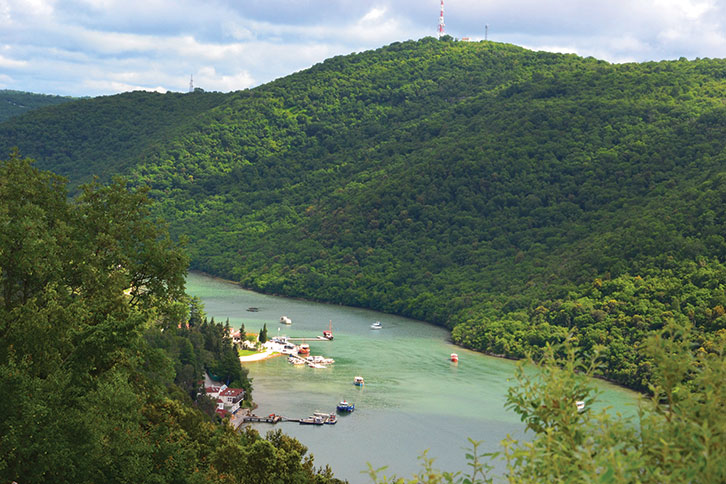
We drove to a vantage point where there are platforms to view the river, but we could only catch glimpses through the trees.
Instead, we descended to the river and walked along the shoreline. Pleasure boats ply regularly between here and Rovinj.
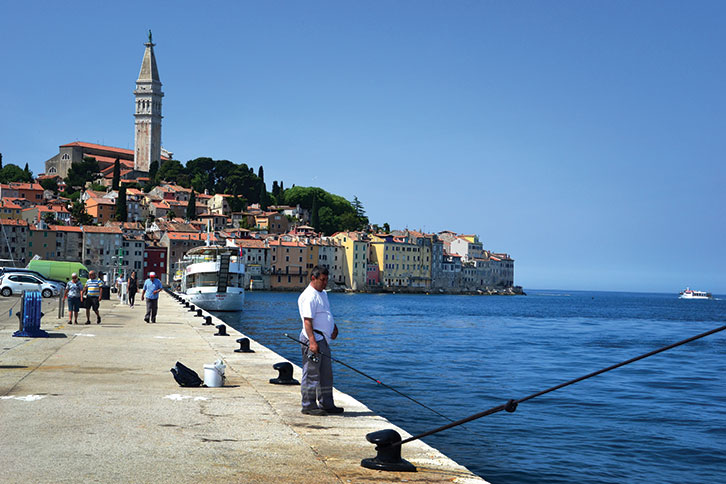
Roman remains
Our ‘must see’ destination was Pula, to the south of the Istrian Peninsula. The attraction for us was the Roman amphitheatre, known as the Arena. Built between 27 BC and 68 AD, this lies in a truly spectacular position overlooking the beautiful Adriatic. We were not disappointed.
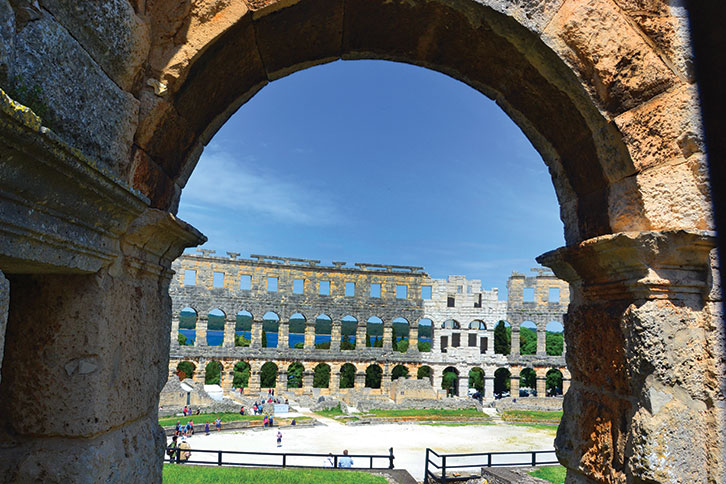
Later on, we turned out thoughts from Roman remains to modern technology, searching online for the tourist information centre, to find out what else there was to see in Pula. I obviously hadn’t done my homework – the whole city is crammed with Roman remains.
We embarked on a self-guided walking tour, starting near the Arena and discovering the Porta Gemina. Thought to be the entrance to a Roman theatre, it leads to the Archaeological Museum.
A few steps further and we arrived at the Gate of Hercules. Unfortunately, modern properties have been built behind it, but there’s a sculpture of the head of Hercules at the top of the arch, hence its name. Then we came to the magnificent Sergian Arch, marking victory at Actium.
Spotting a café, we stopped for coffee and cake. Suitably refreshed, our next stop was the Chapel of Santa Maria Formosa, a Byzantine church decorated with sixth-century mosaics.
Temples and palaces
Returning to the town square, we discovered the Temple of Augustus, dedicated to the first Roman emperor. Originally one of three, this is the only one to have survived. Next to it is the Communal Palace or City Hall, thought to have been built on the site of a Temple of Diana in 1296.
Taking advantage of the good weather next day, we drove inland to the hilltop village of Motovun. We couldn’t miss it, with houses scattered down the hillsides, the top part encircled by walls and the church dominating the whole scene.
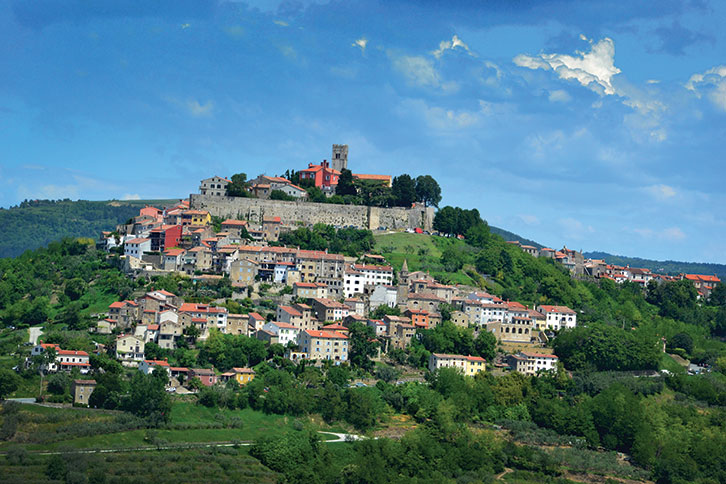
Motovun is considered to be the best preserved medieval fortification in Istria. I admit I was less impressed by the fee to drive up to the car park, but realised later that it saved us an uphill hike. Narrow paved streets lined with bars, restaurants and shops took us to the large square at the top.
After the walk, we sought some refreshments, overlooking the grassy plain and gently rolling countryside laid out below.
Later, we drove to the charming town of Novigrad, with its tree-lined promenade and cycling route beside the sea. It was very hot, and we were thankful for the shady trees.
Walking through the town, we came to a marina packed with leisure craft and lined with restaurants. It was quiet, compared to Motovun and Rovinj, but in high season it would be busy.
Coastline and marinas
After a rest day, we drove just north of the Lim Canal to Vrsar, a fortified medieval town on a hill, overlooking a group of islands.
We enjoyed wandering through the streets and squares lined with colourful houses, arriving at the Church of St Martin at the top. Below we could see the marina, the harbour and newer parts of the town, where we stopped for refreshments.
We moved on to Porec, a little further north. It was busy and clearly very popular, but that was no surprise, because this place has it all: history, coastline and marinas.
Porec itself has been ruled by the Romans, the Venetians, the Austrian Empire, Italy and Yugoslavia, finally becoming Croatian in 1991, so there’s a lot to discover. We saw the splendid Euphrasian Basilica, which houses gold mosaics, and Marafor Square, site of the Roman forum.
Next day, we decided to take a look around Bale, where we strolled up through the quiet streets until we came to an old arch, leading to the stone-built inner town, known as the Castle.
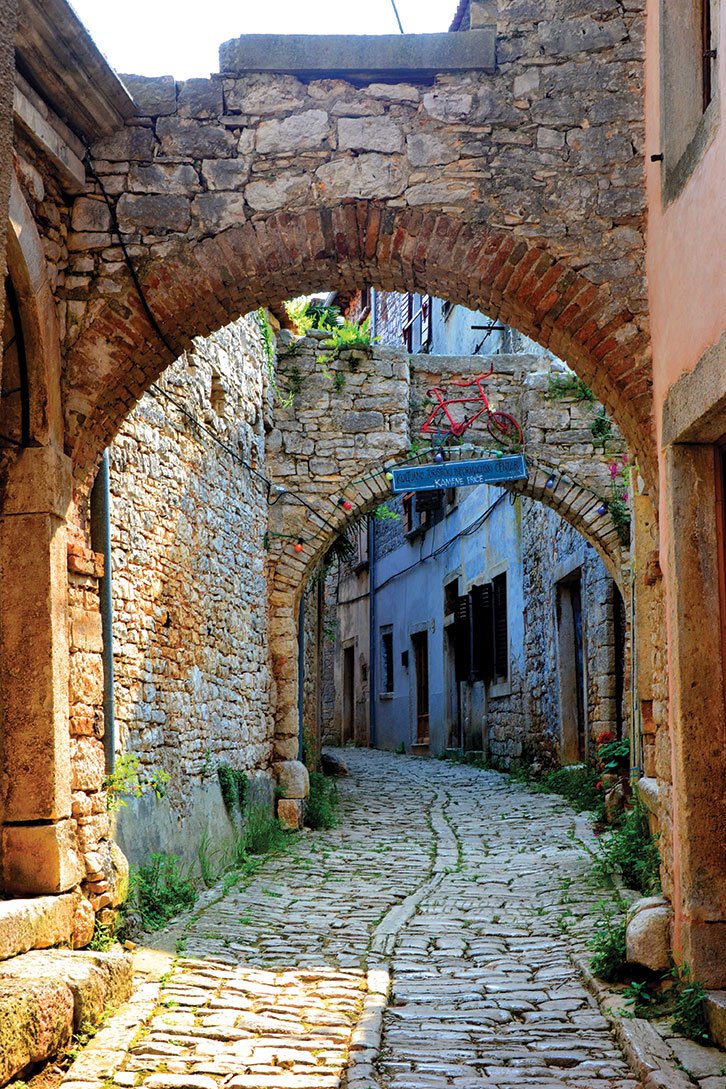
Eventually, we arrived at a small square that housed two churches. The old (formerly Roman) town was so peaceful – apart from a café, there are no shops. On our way back down, we spotted a plaque stating that Casanova often visited Bale, between 1743 and 1747 – you can guess why!
We drove towards the coast, arriving at Fažana, a pretty town where you can take a boat trip to Brijuni National Park. This huge reserve covers two large and 12 small islands. There are several archaeological sites and dinosaur footprints have also been found here. Lacking time, we had to content ourselves with a stroll along the prom.
Camping lakeside
Leaving Croatia behind, we headed for Slovenia and Camping Bled. We caught our first glimpse of the aquamarine waters of Lake Bled as we drove down the main street.
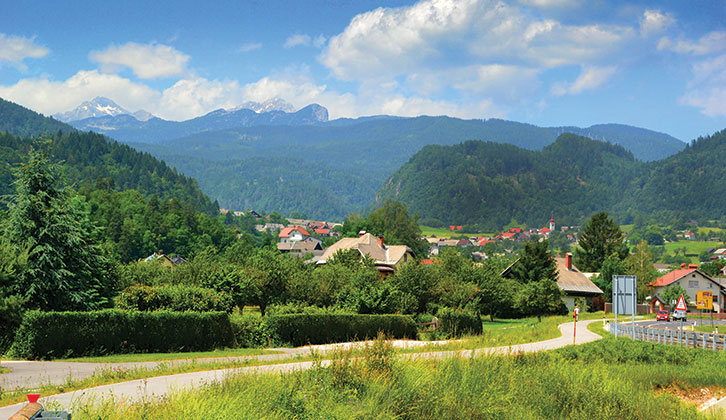
We followed the side of the lake to find the campsite, where bike-riding staff escort you to your pitch (or two pitches in our case – we were a bit mystified about this because there were bigger vehicles than ours on single pitches, but we weren’t about to complain!).
Once we’d set up, we took a short walk over to the lake, which is stunningly beautiful.
The following day, we were keen to explore the area and set off on our bikes along the promenade close to the campsite. Then we climbed a steep hill (thank goodness for ebikes) to reach Bled Castle. We cycled on into Bled and stopped for a cool drink, then returned by the lower route, which hugs the edge of the lake.
Castle and lake
We visited Bled Castle properly next morning. The castle is perched on a cliff overlooking the magnificent Lake Bled and the town. We set off early, having observed while out cycling that it was a long climb after leaving the car park.
We parked up and climbed more steps to the castle. There are three courtyards, a museum, a chapel, a forge, a café and a medieval printshop.
This is the oldest castle in Slovenia, dating back to 1011, but the main attraction is the spectacular view it offers of snow-capped mountains and the renowned Pilgrimage Church of the Assumption of Mary, on an island in the middle of the lake.
We spent the next day exploring by bike, but didn’t make it to our intended destination, the village of Podham, arriving instead at a pretty place called Spodnje Gorje. We stopped at a little café, then continued until we recognised where we were, behind Bled Castle.
The next day, we went in a similar direction, this time driving, to visit Vintgar Gorge. There’s a huge car park here, which costs €5, and we paid €20 to enter the gorge. It was worth it: the River Radovna has carved through dramatic limestone scenery to produce a huge number of glorious waterfalls and rapids.
We strolled along the many paths, bridges and boardwalks to reach the magnificent 16m-high Šum waterfall, a stunning sight.
Later we drove to Lake Bohinj, which is situated in a valley that was quieter and less touristy at the time of our visit, but still very charming and quite beautiful in its own right.
Passing the end of the lake, we then drove on through a pine forest. This quiet country lane was on neither map nor sat nav. We decided to go on, then saw signs for ‘slap’. The only Slovenian word I know, it means ‘waterfall’.
The road ended in a very large car park with a chalet-style hotel, restaurant and bar in the middle. Spotting a sign to the Savica Waterfall, we headed to the entrance (from €2.50).
Uphill to the waterfall
Thank goodness we brought our trekking poles! Basically, it’s an uphill trail, but it’s steps most of the way to the waterfall, and then down again. It was well worth the effort, although it’s not for the faint-hearted.
We were very pleased with our fitness: our walking app declared it was 408ft up in 1.1 miles. Back at the car park, we lunched at the restaurant – we reckoned we had earned ourselves a treat!
We also took the opportunity to sample Lake Bled’s famous cream cake, actually an opulent vanilla and custard cream dessert, which we bought from the site shop on our return.
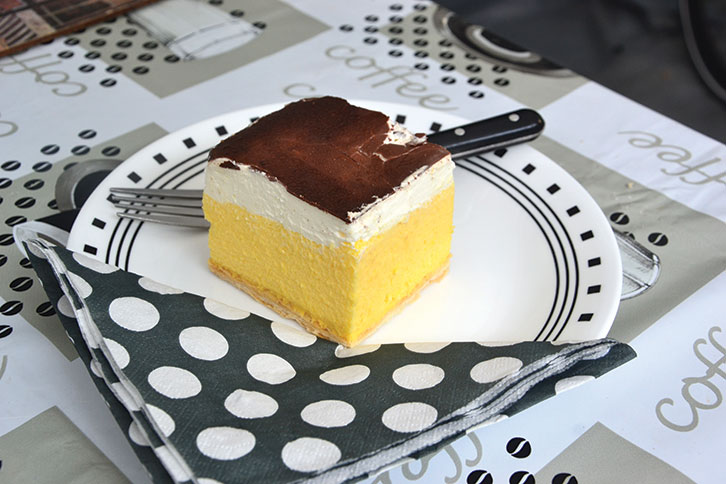
We spent our final day exploring more of the surroundings by bike and enjoyed dinner at the excellent campsite restaurant, taking a last look over scenic Lake Bled.
So why had we struggled to find Campsite Veštar? We’d been looking for signs with a tent or caravan/motorhome symbol, but the site is part of a chain and all of the campsite names are displayed on hoardings with direction arrows. Simple really, and with the faulty sat-nav sensor now repaired, we can’t wait to visit the lovely Adriatic again!
- Looking for a UK campsite to head to instead? Then our guide to the best motorhome sites is worth a look
Tour essentials
When to go
We visited Croatia and Slovenia in late May/early June. Popular places such as Rovinj were busy, while in others, it was evident the season hadn’t started.
Way to go
We took the overnight ferry from Hull to Rotterdam, stopped off in Germany, then crossed the edge of Slovenia until we reached Croatia.
How to book
We booked the ferry via the Caravan and Motorhome Club and used our ACSI book to choose sites. Having read how busy Camping Bled is, we phoned to book a pitch and used CAMC Overseas Site Night Vouchers.
On the road
Most motorways in Croatia are toll roads. You can pay in kuna or use a credit card. In Slovenia, you need a vignette for motorways or dual carriageways – and they do check. Buy one at fuel stations in Slovenia and neighbouring countries, at the border or online.
Where we stayed
Veštar 1, Istra, Croatia HR-52210
- Open: End of April to early October
- Pitches: 458
- Charges (pitch+2+hook-up): 20 euros with ACSI card
This is a large campsite, with lots of facilities. If you’re using ACSI, you are shown available pitches. These are large and have electricity, water and drainage.
Kidriceva 10c, Bled, Slovenia SLO-4260
- Open: 1 April to mid-September
- Pitches: 244
- Charges (pitch+2+hook-up): 20 euros with ACSI card
The site occupies a valley sloping up from the lake. The reception, restaurant and mini-supermarket are at the entrance. This is a very busy site, but it’s not noisy, and it’s friendly and well run.
Food and drink
Site restaurants were excellent and we dined there several times, because campsites tend to be driving or cycling distance away from the nearest town.
Find out more
If you enjoyed reading this, why not take a look at these:
- Dave Roberts embarks on an Orkney Campervan Adventure
If you’ve enjoyed reading this article, why not get the latest news, reviews and features delivered direct to your door or inbox every month. Take advantage of our brilliant Practical Motorhome magazine SUBSCRIBERS’ OFFER and SIGN UP TO OUR NEWSLETTER for regular weekly updates on all things motorhome related.
